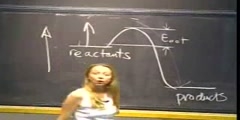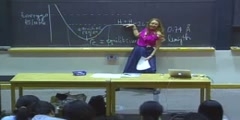Lec 19 - Oxygen and the Chemical Revolution (Beginning to 1789)
"Lec 19 - Oxygen and the Chemical Revolution (Beginning to 1789)" Freshman Organic Chemistry (CHEM 125) This lecture begins a series describing the development of organic chemistry in chronological order, beginning with the father of modern chemistry, Lavoisier. The focus is to understand the logic of the development of modern theory, technique and nomenclature so as to use them more effectively. Chemistry begins before Lavoisier's "Chemical Revolution," with the practice of ancient technology and alchemy, and with discoveries like those of Scheele, the Swedish apothecary who discovered oxygen and prepared the first pure samples of organic acids. Lavoisier's Traité Élémentaire de Chimie launched modern chemistry with its focus on facts, ideas, and words. Lavoisier weighed gases and measured heat with a calorimeter, as well as clarifying language and chemical thinking. His key concepts were conservation of mass for the elements and oxidation, a process in which reaction with oxygen could make a "radical" or "base" into an acid. 00:00 - Chapter 1. The Predecessors of Chemists: Alchemists 08:50 - Chapter 2. Scheele's Acids and Elements 19:58 - Chapter 3. On Radicals, Lavoisier, and the Chemical Revolution 29:54 - Chapter 4. The Elementary Treatise of Chemistry: Facts, Ideas, and Words 36:51 - Chapter 5. New Nomenclature: Elements, Calories, and Radicals Complete course materials are available at the Open Yale Courses website: http://open.yale.edu/courses This course was recorded in Fall 2008.
Video is embedded from external source so embedding is not available.
Video is embedded from external source so download is not available.
Channels: Chemistry (General)
Tags: Antoine Lavoisier Boyle Calorimeter calorimetry nomenclature radical proximate analysis elements
Uploaded by: yalefreshorganic ( Send Message ) on 05-09-2012.
Duration: 47m 10s
Here is the next lecture for this course
Chemical Science-Atomic Theory of Matter ...
41:59 | 31598 viewsWhat Are Elements Compounds And Chemical ...
02:16 | 6271 viewsChemical Science - Breakdown of Octet Rul ...
50:10 | 18723 viewsChemical Science -Transition Metals - Lec ...
50:39 | 20423 viewsChemical Science - Kinetics: Catalysis - ...
48:23 | 17581 viewsChemical Science - Hybridization and Chem ...
51:30 | 21825 viewsChemical Science - Chemical Equilibrium ( ...
44:32 | 18745 viewsLec 22 - Radical and Type Theories (1832- ...
49:15 | 3115 viewsLec 13 - Introduction to Chemical Engineering
39:37 | 2743 viewsChemical Science - Periodic Trends in Ele ...
35:53 | 20548 viewsChemical Science - Covalent Bonds - Lectu ...
47:12 | 16621 viewsChemical Science - Lewis Diagrams - Lectu ...
45:49 | 14734 viewsChemical Science - Bond Energies / Bond E ...
47:24 | 27621 viewsChemical Science - Free Energy of Formati ...
47:47 | 20230 viewsChemical Science - The Shapes of Molecule ...
43:18 | 31936 viewsNo content is added to this lecture.
This video is a part of a lecture series from of Yale
Lecture list for this course
Lec 2 - Force Laws, Lewis Structures and Resonance
Lec 3 - Double Minima, Earnshaw's Theorem and Plum-Puddings
Lec 4 - Coping with Smallness and Scanning Probe Microscopy
Lec 6 - Seeing Bonds by Electron Difference Density
Lec 7 - Quantum Mechanical Kinetic Energy
Lec 8 - One-Dimensional Wave Functions
Lec 9 - Chladni Figures and One-Electron Atoms
Lec 10 - Reality and the Orbital Approximation
Lec 11 - Orbital Correction and Plum-Pudding Molecules
Lec 12 - Overlap and Atom-Pair Bonds
Lec 13 - Overlap and Energy-Match
Lec 14 - Checking Hybridization Theory with XH_3
Lec 15 - Chemical Reactivity: SOMO, HOMO, and LUMO
Lec 16 - Recognizing Functional Groups
Lec 17 - Reaction Analogies and Carbonyl Reactivity
Lec 18 - Amide, Carboxylic Acid and Alkyl Lithium
Lec 20 - Rise of the Atomic Theory (1790-1805)
Lec 21 - Berzelius to Liebig and Wöhler (1805-1832)
Lec 22 - Radical and Type Theories (1832-1850)
Lec 23 - Valence Theory and Constitutional Structure (1858)
Lec 24 - Determining Chemical Structure by Isomer Counting (1869)
Lec 25 - Models in 3D Space (1869-1877); Optical Isomers
Lec 26 - Van't Hoff's Tetrahedral Carbon and Chirality
Lec 27 - Communicating Molecular Structure in Diagrams and Words
Lec 28 - Stereochemical Nomenclature; Racemization and Resolution
Lec 29 - Preparing Single Enantiomers and the Mechanism of Optical Rotation
Lec 30 - Esomeprazole as an Example of Drug Testing and Usage
Lec 31 - Preparing Single Enantiomers and Conformational Energy
Lec 32 - Stereotopicity and Baeyer Strain Theory
Lec 33 - Conformational Energy and Molecular Mechanics
Lec 34 - Sharpless Oxidation Catalysts and the Conformation of Cycloalkanes
Lec 35 - Understanding Molecular Structure and Energy through Standard Bonds
Lec 36 - Bond Energies, the Boltzmann Factor and Entropy
Lec Last - Potential Energy Surfaces, Transition State Theory and Reaction Mechanism
















